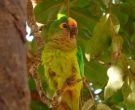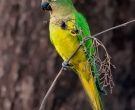Content |
|---|
Description:
A length between 23-28 cm. and a weight between 74-94 g.
The Peach-fronted Parakeet (Eupsittula aurea) has the forecrown bright orange; the crown a deep blue color.
Each eye is surrounded by a circle of small orange feathers, delimited in the anterior zone with blue; front part of the lores orange; cheeks Brown olive; ear-coverts green. Nape, the mantle and back dark green; rump and uppertail-coverts green. Scapulars greenish brown; lesser and median coverts dark green; greater primary coverts dark blue. The primaries blue in the vane inner and tips; the secondaries blue. The flight feather, below, grayish brown; upperwing-coverts colour pale yellowish olive. The throat and the top chest color marron-oliva; the upperparts color olive. Upper, the tail dark green with brown tint in the vane inner and with a bright bluish tinge to an end; by down greyish Brown.
Bill grey-black; close bare periophthalmic bare grey; irises yellowish brown; legs grey.
Both sexes similar.
Immature they have a broad nude patch orbital, frontal band closer, bill pale and the irises grey.
- Sound of the Peach-fronted Parakeet.
Habitat:
The Peach-fronted Parakeet It is present in a wide variety of habitats, specially cleared but a little forested areas, including all kinds of deciduous forest, gallery forest (especially in the South of its range), swamps with Palms mauritia and sheets, also in cultivated areas, below the 600 m.
In the Brazilian Amazon, they are distributed under conditions of low shrub vegetation in sandy soils, avoiding dense evergreen forests. On the inside of the Brazil can be seen in areas caatinga and formations closed with natural grassland.
In general, they can be views in flocks and in isolated pairs during the breeding season.
Has been able to observe them is feeding with the Blue-crowned Conure (Psittacara acuticaudatus) in fruit trees and resting on branches with the Blue fronted Parrot (Amazona aestiva) and the Scaly-headed Parrot (Pionus maximiliani) in Piauí, Brazil.
Reproduction:
Nest in arboreal termite, trunks hollow or in ravines. Birds observed in nests between June and July in Peru and flocks to divide into breeding pairs during the month of January in Mato Grosso. Clutch 2-3 eggs in (Argentina).
Food:
They feed on seeds (not of pulp) of Ilex, Banisteriopsis, Campomanesia, eucalyptus and Symplocos, fruits and flowers of Erythrina and Terminalia, flowers of Qualea and Garyocar and insects, including the termites and fly larvae, beetles and moths. They produce crop damage in some areas.
When feeding in soil (for example of the grain after harvest), its plumage tends to get dirty.
Distribution:
Video – "Peach-fronted Parakeet" |
|---|
Size of the area of distribution (reproduction / resident): 5.730.000 km2
Distributed by the Centre and East of South America. To the North of the Amazonia The species is found in For and Amapá and the island Caviana island (mouth of the Amazon), Brazil, as well as possibly in the south of Suriname. To the South of the Amazonia the Peach-fronted Parakeet extends through of For, Eastern Amazonas, Rondà´nia and Mato Grosso, Brazil, to northeast Bolivia and East of Peru, in where were observed in the Santuario Nacional Pampas del Heath, and eastward through most of the inside of Brazil until Bay, Minas Gerais, Brazil, Mato Grosso from the South and the Northwest of the Alto Paraná Department in Paraguay (in the West and Northeast) and North of Argentina (North of Salta, east of Formosa, Currents and possibly Chaco). The reports of Rio Grande do Sul, Brazil, They seem to be confused.
common in the central area of its distribution area, still it most common aratinga in much of the interior of Brazil. Obviously more local and scarce toward the North and South ends of their range, with very few recent reports in Argentinto (Formosa in 1987 and Currents in 1983), where the abundance historical suggests a descent on a large scale during the century 20.
Conservation:
State of conservation ⓘ |
||
|---|---|---|
 Minor Concern ⓘ
(UICN)ⓘ
Minor Concern ⓘ
(UICN)ⓘ
| ||
• Red List category of the UICN current: Least concern.
• Population trend: Stable.
Place previously within the genus Aratinga.
Its global population size has not been quantified, but this species is described as “common” (Stotz et to the., 1996). Its population suspected to be stable in the absence of evidence of any reduction or substantial threats.
The species has undergone intense trade: from 1981, date on which was included in Appendix II, 61,311 individuals have been captured in the wild for resale in international trade (UNEP-WCMC trade database CITES, January 2005).
"Peach-fronted Parakeet" in captivity:
It´s common in captivity and widely marketed.
Robust, playful, friendly and not so noisy as other species of parrots.
Regularly provide fresh branches to satisfy their need to crack.
It is not a kind of complicated for reproduction in captivity.
Alternative names:
– Peach-fronted Parakeet, Brown-chested Parakeet, Golden-crowned Parakeet, Peach fronted Parakeet, Peach-fronted Conure (English).
– Conure couronnée, Conure à front d’or, Perriche couronnée, Perruche couronnée, Perruche ou (French).
– Goldstirnsittich (German).
– Aratinga-estrela, ararinha, jandaia, jandaia-estrela, maracanã-de-testa-amarela, Periquito-estrela, periquito-rei (Portuguese).
– Aratinga Frentidorada, Aratinga frente durazno, Calacante frente dorada, Calancate Frente Dorada, Cotorra de frente naranja, Maracaná frente naranja, Periquito de Frente Dorada (español).
– Calacante frente dorada, Calancate Frente Dorada (Argentina).
– Cotorra de Frente Dorada (Peru).
– Maracaná frente naranja (Paraguay).
– Tuíiapyteju, Ajuru-juvakang (Guarani).
scientific classification:

– Order: Psittaciformes
– Family: Psittacidae
– Genus: Eupsittula
– Scientific name: Eupsittula aurea
– Citation: (Gmelin, JF, 1788)
– Protonimo: Psittacus aureus
Peach-fronted Parakeet images:
Sources:
– Avibase
– Parrots of the World – Forshaw Joseph M
– Parrots A Guide to the Parrots of the World – Tony Juniper & Mike Parr
– Birdlife
– Photos:
(1) – Peach-fronted Parakeet (also known as the Peach-fronted Conure) in Chapada das Mesas National Park, Brazil By Otávio Nogueira [CC BY 2.0], via Wikimedia Commons
(2) – A Peach-fronted Parakeet in Dourados, Mato Grosso do Sul, Brazil By Dario Sanches from Sao Paulo, Brazil [CC BY-SA 2.0], via Wikimedia Commons
(3) – Peach-fronted Parakeet (Aratinga aurea) perching on a termite mound in Minas Gerais, Brazil By derivative work: Snowmanradio (talk)Aratinga_aurea_-Brazil-8.jpg: Glauco Umbelino [CC BY 2.0], via Wikimedia Commons
(4) – Eupsittula aurea By Petyson Antonio (Own work) [CC BY-SA 4.0], via Wikimedia Commons
(5) – Eupsittula aurea By Petyson Antonio (Own work) [CC BY-SA 4.0], via Wikimedia Commons
– Sounds: (Xeno-canto)







Hello ,They are very noisy?
Hello, how do i know the difference between male and female?
I have a more than 10 years and he is very attached to me, very jealous and other company of the species he or she gets very aggressive.
If you can help me I'd really appreciate!
Excellent work from you, stay with God!
No es posible determine sex, there are no appreciable physical differences between the sexes. Solo se puede know by DNA : Bien by plucked from feather, extracción de sangre the, you want also know el State of sus órganos reproductores, by endoscopy.